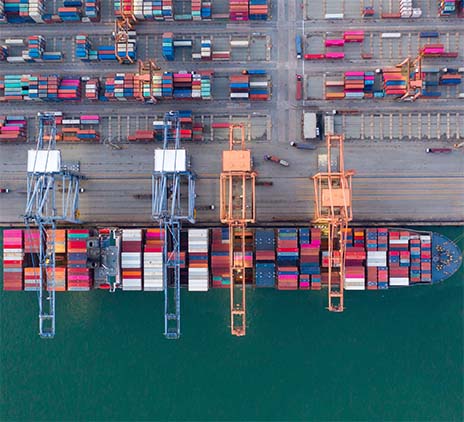-
Why Grant Thornton
Whether you’re growing in one market or many, looking to operate more effectively, managing risk and regulation, or realising stakeholder value, our firms can help.
-
Culture and experience
Grant Thornton’s culture is one of our most valuable assets and has steered us in the right direction for more than 100 years.
-
Global scale and capability
Beyond global scale, we embrace what makes each market unique, local understanding on a global scale.
-
Join our network
In a world that wants more options for high quality services, we differentiate in the market to grow sustainably in today’s rapidly changing environment.
-
Leadership governance and quality
Grant Thornton International Ltd acts as the coordinating entity for member firms in the network with a focus on areas such as strategy, risk, quality monitoring and brand.
-
Africa
24 member firms supporting your business.
-
Americas
31 member firms, covering 44 markets and over 20,000 people.
-
Asia-Pacific
19 member firms with nearly 25,000 people to support you.
-
Europe
53 member firms supporting your business.
-
Middle East
8 member firms supporting your business.
-
Business consulting services
Our business consulting services can help you improve your operational performance and productivity, adding value throughout your growth life cycle.
-
Business process solutions
We can help you identify, understand and manage potential risks to safeguard your business and comply with regulatory requirements.
-
Business risk services
The relationship between a company and its auditor has changed. Organisations must understand and manage risk and seek an appropriate balance between risk and opportunities.
-
Cybersecurity
As organisations become increasingly dependent on digital technology, the opportunities for cyber criminals continue to grow.
-
Forensic services
At Grant Thornton, we have a wealth of knowledge in forensic services and can support you with issues such as dispute resolution, fraud and insurance claims.
-
Mergers and acquisitions
We work with entrepreneurial businesses in the mid-market to help them assess the true commercial potential of their planned acquisition and understand how the purchase might serve their longer-term strategic goals.
-
Recovery and reorganisation
Workable solutions to maximise your value and deliver sustainable recovery.
-
Transactional advisory services
We can support you throughout the transaction process – helping achieve the best possible outcome at the point of the transaction and in the longer term.
-
Valuations
We provide a wide range of services to recovery and reorganisation professionals, companies and their stakeholders.
-
Sustainability advisory
We can assist you with a variety of sustainability advice depending on your needs, ranging from initial strategy development, reporting and compliance support, through to carbon measurement and management.

-
IFRS
At Grant Thornton, our IFRS advisers can help you navigate the complexity of financial reporting from IFRS 1 to IFRS 17 and IAS 1 to IAS 41.
-
Audit quality monitoring
Having a robust process of quality control is one of the most effective ways to guarantee we deliver high-quality services to our clients.
-
Global audit technology
Our global assurance technology platform provides the ability to conduct client acceptance, consultations and all assurance and other attestation engagements.
-
Sustainability assurance
Our sustainability assurance services are based on our global network of specialists, helping you make more efficient decisions for the good of your organisation.

-
Corporate and business tax
Our trusted teams can prepare corporate tax files and ruling requests, support you with deferrals, accounting procedures and legitimate tax benefits.
-
Direct international tax
Our teams have in-depth knowledge of the relationship between domestic and international tax laws.
-
Global mobility services
Through our global organisation of member firms, we support both companies and individuals, providing insightful solutions to minimise the tax burden for both parties.
-
Indirect international tax
Using our finely tuned local knowledge, teams from our global organisation of member firms help you understand and comply with often complex and time-consuming regulations.
-
Transfer pricing
The laws surrounding transfer pricing are becoming ever more complex, as tax affairs of multinational companies are facing scrutiny from media, regulators and the public
-
Africa tax desk
A differentiating solution adapted to the context of your investments in Africa.
-
Sustainability tax
Through our sustainability tax advisory services, we can advise how environmental taxes, incentives, and obligations can impact your progress, requiring alignment with governmental and legislative pressures.

-
 Banking Holding banking to account: the real diversity and inclusion pictureWe explore how the banking sector can continue to attract, retain and nurture women to build a more diverse and inclusive future.
Banking Holding banking to account: the real diversity and inclusion pictureWe explore how the banking sector can continue to attract, retain and nurture women to build a more diverse and inclusive future. -
 Sustainability From voluntary to mandatory ESG: How banks can future-proof their operationsAs we move from voluntary ESG initiatives to mandatory legislation, we explore what the banking sector needs to prioritise.
Sustainability From voluntary to mandatory ESG: How banks can future-proof their operationsAs we move from voluntary ESG initiatives to mandatory legislation, we explore what the banking sector needs to prioritise. -
 IFRS IFRS 9 - Audit of Expected Credit LossesGPPC releases The Auditor’s response to the risks of material misstatement posed by estimates of expected credit losses under IFRS 9
IFRS IFRS 9 - Audit of Expected Credit LossesGPPC releases The Auditor’s response to the risks of material misstatement posed by estimates of expected credit losses under IFRS 9 -
 growthiQ Steering your company to long-term successHistory has something important to tell us about the difficulties of steering a business to long-term success – through seismic shifts in technology, consumer demands and product development. With that in mind it’s unsurprising that over half the world’s largest companies in the early 1900s had shut their doors by the late 1990s. Some, however, have endured.
growthiQ Steering your company to long-term successHistory has something important to tell us about the difficulties of steering a business to long-term success – through seismic shifts in technology, consumer demands and product development. With that in mind it’s unsurprising that over half the world’s largest companies in the early 1900s had shut their doors by the late 1990s. Some, however, have endured.
-
 International Financial Reporting Standards Implementation of IFRS 17 ‘Insurance Contracts’The auditor’s response to the risks of material misstatement arising from estimates made in applying IFRS 17 ‘Insurance Contracts’
International Financial Reporting Standards Implementation of IFRS 17 ‘Insurance Contracts’The auditor’s response to the risks of material misstatement arising from estimates made in applying IFRS 17 ‘Insurance Contracts’ -
 IFRS Get ready for IFRS 17After twenty years of development the IASB has published IFRS 17 ‘Insurance Contracts’, find out more.
IFRS Get ready for IFRS 17After twenty years of development the IASB has published IFRS 17 ‘Insurance Contracts’, find out more.
-
 Global business pulse - industry analysis Mid-market recovery spreads to more industriesThe index results for 13 key industries of the mid-market reveals a very uneven recovery from COVID-19
Global business pulse - industry analysis Mid-market recovery spreads to more industriesThe index results for 13 key industries of the mid-market reveals a very uneven recovery from COVID-19 -
 Global business pulse - industry analysis A very uneven recovery across industriesThe index results for 13 key industries of the mid-market reveals a very uneven recovery from COVID-19
Global business pulse - industry analysis A very uneven recovery across industriesThe index results for 13 key industries of the mid-market reveals a very uneven recovery from COVID-19 -
 Global business pulse - Sector analysis Clear patterns of damage from COVID-19 across the industriesThe index results for 12 key sectors of the mid-market reveal just how much or little the various parts of the economy were impacted by COVID-19.
Global business pulse - Sector analysis Clear patterns of damage from COVID-19 across the industriesThe index results for 12 key sectors of the mid-market reveal just how much or little the various parts of the economy were impacted by COVID-19. -
 Not for profit Mission: possible – putting impact at the heart of charityGlobal charitable continues to decline and charity leaders are increasingly looking at their own unique impact journey.
Not for profit Mission: possible – putting impact at the heart of charityGlobal charitable continues to decline and charity leaders are increasingly looking at their own unique impact journey.
-
 Access to finance Raise finance to invest in changePrepare your business to raise finance to invest in change.
Access to finance Raise finance to invest in changePrepare your business to raise finance to invest in change. -
 Private equity firms Private equity in the mid-market: reshaping strategies for 2021When the global COVID-19 pandemic stormed across the globe in early 2020, the private equity sector was hit hard but deals are coming back to the market.
Private equity firms Private equity in the mid-market: reshaping strategies for 2021When the global COVID-19 pandemic stormed across the globe in early 2020, the private equity sector was hit hard but deals are coming back to the market. -
 Mid-market businesses Getting ready for private equity investmentOur specialists explore how private equity firms are now working with their portfolios and how the mid-market can benefit from investment.
Mid-market businesses Getting ready for private equity investmentOur specialists explore how private equity firms are now working with their portfolios and how the mid-market can benefit from investment. -
 Mid-market businesses Myth-busting private equityNervous about partnering with Private Equity? We explore some of the common myths we come across when speaking to mid-market businesses about PE investment.
Mid-market businesses Myth-busting private equityNervous about partnering with Private Equity? We explore some of the common myths we come across when speaking to mid-market businesses about PE investment.
-
 Public sector Helping build the government of tomorrow, todayLearn about the Grant Thornton US public sector team.
Public sector Helping build the government of tomorrow, todayLearn about the Grant Thornton US public sector team. -
 Global business pulse - industry analysis Mid-market recovery spreads to more industriesThe index results for 13 key industries of the mid-market reveals a very uneven recovery from COVID-19
Global business pulse - industry analysis Mid-market recovery spreads to more industriesThe index results for 13 key industries of the mid-market reveals a very uneven recovery from COVID-19 -
 Global business pulse - industry analysis A very uneven recovery across industriesThe index results for 13 key industries of the mid-market reveals a very uneven recovery from COVID-19
Global business pulse - industry analysis A very uneven recovery across industriesThe index results for 13 key industries of the mid-market reveals a very uneven recovery from COVID-19 -
 Global business pulse - Sector analysis Clear patterns of damage from COVID-19 across the industriesThe index results for 12 key sectors of the mid-market reveal just how much or little the various parts of the economy were impacted by COVID-19.
Global business pulse - Sector analysis Clear patterns of damage from COVID-19 across the industriesThe index results for 12 key sectors of the mid-market reveal just how much or little the various parts of the economy were impacted by COVID-19.
-
 Industries European Real Estate PodcastJessica Patel, Tax Partner at Grant Thornton UK speaks with tax partners and directors across the network to share their insights on the real estate market and some of the challenges.
Industries European Real Estate PodcastJessica Patel, Tax Partner at Grant Thornton UK speaks with tax partners and directors across the network to share their insights on the real estate market and some of the challenges. -
 Industries European Real Estate PodcastJessica Patel, Tax Partner at Grant Thornton UK speaks with tax partners and directors across the network to share their insights on the real estate market and some of the challenges.
Industries European Real Estate PodcastJessica Patel, Tax Partner at Grant Thornton UK speaks with tax partners and directors across the network to share their insights on the real estate market and some of the challenges. -
 Global business pulse - industry analysis Mid-market recovery spreads to more industriesThe index results for 13 key industries of the mid-market reveals a very uneven recovery from COVID-19
Global business pulse - industry analysis Mid-market recovery spreads to more industriesThe index results for 13 key industries of the mid-market reveals a very uneven recovery from COVID-19 -
 Global business pulse - industry analysis A very uneven recovery across industriesThe index results for 13 key industries of the mid-market reveals a very uneven recovery from COVID-19
Global business pulse - industry analysis A very uneven recovery across industriesThe index results for 13 key industries of the mid-market reveals a very uneven recovery from COVID-19
-

-
 Global business pulse - industry analysis Mid-market recovery spreads to more industriesThe index results for 13 key industries of the mid-market reveals a very uneven recovery from COVID-19
Global business pulse - industry analysis Mid-market recovery spreads to more industriesThe index results for 13 key industries of the mid-market reveals a very uneven recovery from COVID-19 -
 Global business pulse - industry analysis A very uneven recovery across industriesThe index results for 13 key industries of the mid-market reveals a very uneven recovery from COVID-19
Global business pulse - industry analysis A very uneven recovery across industriesThe index results for 13 key industries of the mid-market reveals a very uneven recovery from COVID-19 -
 Retail How retail is positioning for successCOVID-19 provided some hard lessons for the retail industry. It is time to turn those into sustainable and well executed growth strategies in 2021.
Retail How retail is positioning for successCOVID-19 provided some hard lessons for the retail industry. It is time to turn those into sustainable and well executed growth strategies in 2021.
-
 Technology Mid-market tech companies lead the way on diversity and inclusionWe explore how the mid-market tech sector can continue to build and nurture a culture that’s increasingly more diverse and inclusive for women.
Technology Mid-market tech companies lead the way on diversity and inclusionWe explore how the mid-market tech sector can continue to build and nurture a culture that’s increasingly more diverse and inclusive for women. -
 Tax Resetting global tax rules after the pandemicBusinesses are seeing rising challenges, and finance heads are dealing with a range of new measures. To say the next 12 months are critical for businesses is an understatement.
Tax Resetting global tax rules after the pandemicBusinesses are seeing rising challenges, and finance heads are dealing with a range of new measures. To say the next 12 months are critical for businesses is an understatement. -
 TECHNOLOGY International tax reform: the potential impact on the technology industryIn this article, we’ve summarised key elements of the global tax reform proposals, their potential impact on technology industry and advice from our digital tax specialists on what technology companies can do to prepare.
TECHNOLOGY International tax reform: the potential impact on the technology industryIn this article, we’ve summarised key elements of the global tax reform proposals, their potential impact on technology industry and advice from our digital tax specialists on what technology companies can do to prepare. -
 TMT TMT industry: Fully charged or on standby?Our research revealed five key trends that resonated with Technology, Media and Telecoms (TMT) industry leaders around the world. We asked a panel of our experts from UK, US, India Ireland and Germany, to give us their reaction to the findings.
TMT TMT industry: Fully charged or on standby?Our research revealed five key trends that resonated with Technology, Media and Telecoms (TMT) industry leaders around the world. We asked a panel of our experts from UK, US, India Ireland and Germany, to give us their reaction to the findings.
-
 TMT TMT industry: Fully charged or on standby?Our research revealed five key trends that resonated with Technology, Media and Telecoms (TMT) industry leaders around the world. We asked a panel of our experts from UK, US, India Ireland and Germany, to give us their reaction to the findings.
TMT TMT industry: Fully charged or on standby?Our research revealed five key trends that resonated with Technology, Media and Telecoms (TMT) industry leaders around the world. We asked a panel of our experts from UK, US, India Ireland and Germany, to give us their reaction to the findings. -
 Cybersecurity One size fits nothingTechnology companies must adopt a new approach to digital risk: those that successfully develop a reputation for digital trust by demonstrating an unwavering commitment to cyber security and data privacy will be able to carve out a competitive advantage.
Cybersecurity One size fits nothingTechnology companies must adopt a new approach to digital risk: those that successfully develop a reputation for digital trust by demonstrating an unwavering commitment to cyber security and data privacy will be able to carve out a competitive advantage. -
 Technology, media & telecommunications Why it’s time for a 5G reality checkFigures suggest the mobile sector is maturing. While data usage continues to soar, mobile revenues are expected to flatten out over the next few years.
Technology, media & telecommunications Why it’s time for a 5G reality checkFigures suggest the mobile sector is maturing. While data usage continues to soar, mobile revenues are expected to flatten out over the next few years. -
 GrowthiQ Is blockchain right for your business?Blockchain has been seized upon by the financial services sector, where it is playing a crucial role in tracking and authenticating transactions.
GrowthiQ Is blockchain right for your business?Blockchain has been seized upon by the financial services sector, where it is playing a crucial role in tracking and authenticating transactions.
-
 International business Mid-market businesses lifted by rising tide of optimismOptimism among global mid-market business leaders rose to 67% in the first half of this year and they are markedly more optimistic about their prospects with global optimism having increased by 8%.
International business Mid-market businesses lifted by rising tide of optimismOptimism among global mid-market business leaders rose to 67% in the first half of this year and they are markedly more optimistic about their prospects with global optimism having increased by 8%. -
 Global business pulse - industry analysis Mid-market recovery spreads to more industriesThe index results for 13 key industries of the mid-market reveals a very uneven recovery from COVID-19
Global business pulse - industry analysis Mid-market recovery spreads to more industriesThe index results for 13 key industries of the mid-market reveals a very uneven recovery from COVID-19 -
 Hotels COVID-19: Checking in with the hotel industry one year onCOVID-19 provided some hard lessons for the hotel sector. It is time to turn those into sustainable and well executed growth strategies.
Hotels COVID-19: Checking in with the hotel industry one year onCOVID-19 provided some hard lessons for the hotel sector. It is time to turn those into sustainable and well executed growth strategies. -
 Global business pulse - industry analysis A very uneven recovery across industriesThe index results for 13 key industries of the mid-market reveals a very uneven recovery from COVID-19
Global business pulse - industry analysis A very uneven recovery across industriesThe index results for 13 key industries of the mid-market reveals a very uneven recovery from COVID-19
- By topic
-
Women in Business 2025
For 21 years, the Women in Business report has tracked the proportion of women in senior roles in the mid-market. Progress has been made but with gender equity over 25 years away, that isn’t soon enough.
-
Scaling sustainability
Mid-market firms are scaling sustainability for growth, not just compliance. Grant Thornton’s International Business Report (IBR) 2025 report reveals how sustainability investments are driving profitability, resilience and global expansion — despite regulatory shifts and political uncertainty.
-
Thriving through disruption
Instability has come to define the global business landscape and the ability for mid-market firms to thrive through disruption is becoming a key differentiator.
-
Trade in transition
A shifting global trade landscape is contributing to rising uncertainty, but could it also unlock new opportunites for adaptable mid-market businesses while larger companies opt to wait and see?
-
CFO success: Inspiring change in female mid-market leadership
Women holding the CFO role is nearing parity – reshaping finance leadership and potentially helping increase female representation across all senior roles.
-
International business: Mid-market growth and expansion
The mid-market looks to international business opportunities for growth.
-
Women in Business 2025: Impacting the missed generation
The 2025 Women in Business report explores the external pressures and internal drivers that impact gender diversity in senior roles in the mid-market.
-
CFO success: Inspiring change in female mid-market leadership
Women holding the CFO role is nearing parity – reshaping finance leadership and potentially helping increase female representation across all senior roles.
-
Women in tech: A pathway to gender balance in top tech roles
Grant Thornton’s 2024 Women in Business data suggests we are far from achieving parity within the mid-market technology sector.
-
Women in leadership: a pathway to better performance
What makes the benefits of gender parity compelling is the impact it can have on commercial performance.
-
Women in Business 2024
2024 marks the 20th year of Women in business where we monitor and measure the proportion of women occupying senior management roles around the world.
-
Women in business: Regional picture
We saw an increase in the percentage of senior management roles held by women, on a global level, but there are some significant regional and country variations.
-
Pathways to Parity: Leading the way
To push towards parity of senior management roles held by women, who leads within an organisation is vital.
-
Generating real change with a long-term focus
The most successful strategy to achieve parity of women in senior management is one which stands alone, independent of an ESG strategy.
-
People at the heart of great business
Businesses have started to put guidelines and incentives in place, focused on driving employees back to the office.
-
Scaling sustainability
Mid-market firms are scaling sustainability for growth, not just compliance. Grant Thornton’s International Business Report (IBR) 2025 report reveals how sustainability investments are driving profitability, resilience and global expansion — despite regulatory shifts and political uncertainty.
-
The journey to a sustainable future
The world needs a sustainable mid-market. It’s vital to economies, societies and the planet. Businesses, governments, and other stakeholders must work collaboratively to make sure this vital part of the world economy succeeds.
-
Ten considerations for preparing TCFD climate-related financial disclosures
Insights for organisations preparing to implement the International Sustainability Standards Board (ISSB)’s Standards.
-
COP28
COP28 was the first time there has been a global stocktake on progress against the Paris Agreement.
-
Transition Plan Taskforce publishes its final disclosure framework
As organisations in the private sector make commitments and plans to reach net zero, there's a growing need for stakeholders to be able to assess the credibility of their transition plans.
-
Thriving through disruption
Instability has come to define the global business landscape and the ability for mid-market firms to thrive through disruption is becoming a key differentiator.
-
Trade in transition
A shifting global trade landscape is contributing to rising uncertainty, but could it also unlock new opportunites for adaptable mid-market businesses while larger companies opt to wait and see?
-
International business: Mid-market growth and expansion
The mid-market looks to international business opportunities for growth.
-
Top five constraints to international business in the mid-market
Top five major constraints that are testing the mid-market’s ability to grow their businesses internationally.
-
Brand and international marketing – breaking global barriers
Brand has been identified as a key driver of mid-market success when looking to grow and develop international business.
-
The key to international business: Investing in people
How can recruitment and retention help grow international business?
-
Building resilience in international business
Evolving supply chains and trade patterns amid ongoing global uncertainty.
-
Example Financial Statements
The 2025 Interim Financial Statements provide general guidance on preparing interim financial statements in accordance with IFRS Accounting Standards.
-
IFRS 8
Our ‘Insights into IFRS 8’ series considers some key implementation issues and includes interpretational guidance in certain problematic areas.
-
IFRS 16
Are you ready for IFRS 16? This series of insights will help you prepare.
-
IAS 36
Insights into IAS 36 provides assistance for preparers of financial statements and help where confusion has been seen in practice.
-
IFRS 17
Explaining the key features of the Standard and providing insights into its application and impact.
-
Pillar 2
Key updates and support for the global implementation of Pillar 2.
-
Global expatriate tax guide
Growing businesses that send their greatest assets – their people – overseas to work can face certain tax burdens, our global guide highlights the common tax rates and issues.
-
International indirect tax guide
Navigating the global VAT, GST and sales tax landscape.
-
Global transfer pricing guide
Helping you easily find everything you need to know about the rules and regulations regarding transfer pricing and Country by Country reporting for every country you do business with.

Please click on each section to expand further:
Value Added Tax (VAT) is the principal type of indirect taxation in Belgium and in other European Union (EU) countries.
It is a tax on consumption applied during the production and distribution process for goods and services. It is applied on goods and certain services entering Belgium as well as supplies of goods and services located in Belgium. Although VAT is ultimately borne by the consumer as it is included in the price paid, the responsibility for charging, collecting and paying towards the tax authority lies at each stage of the process with the business supplying goods or services.
A transaction is within the scope of Belgian VAT and should be reported in the Belgian VAT return if the following conditions are cumulatively met:
-
Qualification as it concerns (one of the four) taxable transactions: supply of goods, supply of services, intra-Community supply or importation. A supply of goods is defined as a transfer of the (economic) power to dispose over a good pursuant to a contract for consideration. A supply of services is defined as any transaction which is not considered as a supply of goods.
An intra-Community supply is a supply of goods with transportation of these goods to another EU member state. The importation of goods means that non-EU goods are brought in ‘free circulation’ and they can then be released for use in the home market.
- Taking place in Belgium.
- Performed by a taxable person.
- In the course of any business carried on by that person or entity.
A business registered for the VAT will charge VAT (output VAT) on its sales (unless payment of the Belgian VAT is shifted to the customer ) and will incur VAT (input VAT) on its purchases (including any VAT paid at importation).
The difference between the output VAT and the deductible input VAT in each accounting period (month or quarter) will result in either:
- VAT amount payable by the business to the VAT authority,
- VAT credit amount, for which a refund can be claimed at the end of the quarter,
- zero balance (when only incoming transactions for which the VAT) should be self-accounted for and only VAT exempt outgoing transactions are performed).
There are four rates of VAT that are applied to goods and services in Belgium:
- standard rate (21%)
- reduced rate (6%)
- intermediate rate (12%)
- zero rate (0%)
Also, a range of VAT exemptions apply, some with VAT deduction right (such as export and intra-Community supplies) and some without VAT deduction right (such as financial and insurance services, medical services, rent of real estate (with exceptions) and cultural and sport-related services). Businesses that perform VAT exempt supplies without VAT deduction right are unable to claim all of the input tax that they incur. This means that, the VAT paid to suppliers will be a ‘real’ cost.
Most goods imported into Belgium from outside the EU are subject to VAT. The import VAT will have to be paid by the importer at the time of importation. When the importation is for business purposes and the importer is registered for VAT, it may be possible to reclaim the VAT via the Belgian VAT return (subject to certain rules). Under certain conditions, an import VAT deferral license (ET 14.000 license) can be requested.
This means that the import VAT is to be declared by the importer under a ‘self- account’ scheme: the VAT payable and the deductible VAT will be reported in the same Belgian VAT return. This system avoids pre-financing of the Belgian VAT by the importer.
It is also important to note the interaction between VAT and customs. Customs duties are levied across the EU at the place where goods are imported into the community. It is levied to bring the cost of goods produced outside the EU up to the same level as those produced within the EU.
Once customs duties (and VAT) have been paid by the importer, the goods are in ‘free circulation’ and can then be released for use in the home market. Unlike other indirect taxes, such as VAT, once the custom duty has been paid, it is usually not recoverable by the importer.
Consequently, it therefore represents a bottom-line cost to the importing business, if it cannot be passed on by a price increase. VAT is charged on the value of the importation, including any customs duties.
In Belgium, there is no registration limit for VAT. However, for companies there is a special optional VAT regime, the so-called ‘small enterprises regime’. Such small enterprises whose annual turnover in Belgium is below €25,000 (excl.VAT) and annual EU turnover is below € 100.000 can benefit from a VAT exemption on the performed supply of goods and services (without VAT deduction right). Some goods and services and sectors are excluded from the special regime (e.g. immovable work sector, hospitality sector, tobacco products).
Since 2025, foreign taxable persons can also request the application of this special VAT regime when not exceeding both the national and the global threshold of € 100.000. If not requested, Belgian VAT will remain due.
A lump-sum penalty may be imposed by the tax authorities, if a taxable person fails to register at the appropriate time, as well as lump-sum penalties per VAT return, yearly sales listing and intra- Community supply listing not submitted for the related period.
For these purposes, a ‘taxable person’ includes any legal entity, also non-profit organisations, performing taxable transactions for which they are the VAT debtor.
Two or more entities can form a VAT group if:
- each entity is established, or has a fixed establishment, in Belgium
- they comply with the three ‘control and links’ test, being financial, organizational and economical.
- all entities should qualify as VAT taxable persons.
One single VAT return should be submitted by the VAT group. An entity can only be a member of one single VAT group. The main advantage of a VAT group is that in principle any supply of goods or services by a member of the group to another member is disregarded for VAT purposes. This results in advantages: (1) VAT optimized structuring for immovable property within the group, (2) avoidance of double VAT deduction limitation, (3) optimizing VAT pre-financing and (4) avoidance of VAT risk for intra-group transactions.
There are also some disadvantages, for example all VAT group members (including former members) are jointly and severally liable for the VAT debt of the group during the period of their membership. Consequently, any decision on whether a VAT group is opportune should be taken with care.
Since 2025, foreign taxable persons can also request the application of this special VAT regime when not exceeding both the national and the global threshold of € 100.000 If not requested, Belgian VAT will remain due.
For occasional/one-off transactions a simplified procedure exists with a license for non-registration and filing of a special (one-off or a few) VAT return. In such case, no Belgian VAT number (only a so-called ‘reference number’) will be assigned and Belgian input VAT will be recoverable via the special (one-off or limited number) VAT return.
In some cases, a special registration procedure can be applied for organizers of events such as conferences in Belgium. One of the conditions to apply this special procedure is that the Belgian turnover cannot exceed €200.000 on a yearly basis. In such case, special returns will have to be filed to pay the VAT due and deduct the incoming VAT.
Registration for VAT in Belgium may also be required when a non-established EU business is involved with distance selling. Distance selling occurs when a taxable supplier in one EU country supplies and delivers goods to a non-taxable customer in another EU country. Non-taxable customers include private individuals, and businesses and other organizations not registered for VAT (either because of their size or the fact that they are exempt from having to register due to the nature of their activities).
Distance sales will be subject to VAT at the appropriate rate in the customer’ country (unless they qualify as a micro-entity with a global turnover below € 10.000).
The place of supply for electronically supplied services provided to private consumers (B2C) is the Member State where the consumer is established. This Member State determines amongst others the applicable VAT rate.
Suppliers have the choice to either register for VAT in each Member State where their customers reside, or elect to register under the VAT OSS simplification scheme in a single Member State.
A taxable person can operate OSS in Belgium in the following cases:
- taxable person with head office in Belgium,
- taxable person with head office outside EU and, with permanent establishments in EU including Belgium,
- taxable person with head office outside EU, without permanent establishment in EU.
The OSS can also be used to report the local sales to customers in a Member State in which suppliers of electronically supplied services are established (since July 2021 integration to one single OSS return for services and goods).
Foreign companies that perform taxable transactions in Belgium in principle need to obtain a Belgian VAT number. More specifically, an individual VAT number is required. In that respect, EU companies can choose between a direct VAT identification or assignment of a fiscal representative. Non-EU companies are obliged to assign a fiscal representative.
For certain limited transactions instead of requesting an individual VAT number, the Belgian VAT reporting can be done under a special global VAT registration number (BE 0796.5 or BE 0796.6) assigned to a global fiscal representative. By means of example it concerns the following transactions:
- importation followed by a local supply of the same (untreated) goods.
- non-Community goods sold under a VAT warehouse regime.
Under this system, the global VAT representative will submit a single VAT return for multiple taxable persons.
For occasional/one-off transactions, a simplified procedure exists with a license for non-registration and filing of a special (one-off or few) VAT return (see above).
In principle, a monthly VAT return has to be submitted. However, if the annual turnover realized in Belgium does not exceed €2.5 million, quarterly VAT returns can be filed (option). At the moment that the value of intra-Community supplies of goods exceeds the threshold of €50,000 per quarter, obligatory monthly ESLs and monthly VAT returns need to be submitted.
For companies trading in certain products, a monthly VAT return is obligatory if the annual turnover is more than €250,000 (i.e. energy products, mobile phones and computers and their peripherals, accessories and components, as well as land vehicles).
All VAT returns should be submitted for the monthly filing regime within 20 days after the end of the month (or for quarterly filing regime within 25 days after the end of the quarter), together with the payment of any VAT amount due. Where VAT recoverable exceeds VAT payable, a VAT refund will, in principle, be paid back by the VAT authorities when the special refund box is ticked on the VAT return.
Where VAT payable exceeds VAT recoverable, the difference should be paid by the 20th of the next month (for monthly VAT returns) or 25th of the next month after the tax period (for quarterly VAT returns).
For the late filing of a VAT return, the Belgian VAT authorities can impose strict penalties:
- First offense: €500,
- Second offense: €1,250,
- Third offense: €2,500,
- Subsequent offenses: €5,000,
- If the VAT return is filed late and still but within five months, the penalty is €100 per month of delay, capped at €500.
For late payment of the VAT amount due, the penalty is determined based on the timing of the VAT return submission:
• 5% of the VAT due if the VAT return was submitted on time.
• 10% if the VAT return was submitted late.
• 15% if the VA authorities had to issue a final replacement return.
Businesses registered for VAT purposes in Belgium and making supplies of goods or services to recipients registered for VAT in another EU country are required to submit EC Sales Lists (ESL’S). The ESLs should mention the VAT number of the recipients of the goods or services.
Above the threshold of €50,000 of intra - community supplies of goods per quarter, monthly ESLs should be submitted. Quarterly ESLs can be submitted (by option) below the € 50.000 threshold, unless the company is already filing monthly VAT returns (obligatory monthly regime for turnover threshold above €2.5 million). The monthly ESL should be submitted no later than the 20th and the quarterly ESL no later than the 25th of the month following the taxable period. If there is nothing to report, no ESL should be submitted for that month or quarter. For a VAT group, each member of the VAT group should submit its own ESL.
In addition, if the value of the intra-EU transactions of goods dispatched to or arriving from another EU country is above the annual threshold (resp. €1.000.000 and €1.500.000) a supplementary declaration (the so-called intrastat arrival and dispatch declaration) should be submitted on a monthly basis.
Finally, each year a listing of the supplies to Belgian customers registered with a VAT number in Belgium should be submitted (‘yearly sales listing’). This yearly sales listing includes the following information:
- VAT number of the customers,
- total turnover per customer,
- the total VAT amount.
The yearly sales listing should be submitted by 31 March of the following year. If no supplies have been made during a year to Belgian customers registered with VAT in Belgium, the VAT authorities should be notified (by ticking a box on the VAT return for “nil yearly sales listing”) or a nil annual sales listing should be submitted. For a VAT group, each member of the VAT group should submit its own annual sales listing.
In case the infraction was committed with the intention to evade VAT or to facilitate VAT evasion, the 200% VAT penalty will be claimed. In other cases, reduced proportional VAT penalties apply, ranging between 5% and 100% (for some breaches, a difference is made whether it concerns the first, second or next breach). Criminal proceedings and penal sanctions may arise in the case of more serious matters (e.g. fraud).
The Belgian VAT legislation foresees amongst others the following VAT penalties:
- Non (or late) payment of Belgian VAT 5%-15% amount due as result of the VAT return,
- Non - issuance of an invoice 100%,
- Certain essential incorrect invoice statements 100%,
- Non - issuance import document 5%,
- Incorrect applications of the reverse change mechanism 20%.
For a range of errors and omissions resulting in non-compliance with the VAT rules, administrative VAT penalties can be imposed. There are two types of VAT penalties: (reduced) proportional penalties and lump-sum penalties. In addition to the penalties, interest for late payment at 0.66% per month can be claimed. In case of a spontaneous VAT regularization (i.e. prior to any intervention/question of any tax authority) no proportional penalty will be due, but still a lump sum penalty could be imposed.
- Incorrect VAT deduction 10%.
- Non-reporting of transactions(without VAT due under reverse change) 10%.
Additional penalties
Lump sum penalties ranging between €25 and €5,000 are foreseen for other breaches of the VAT code. The penalty will depend on the nature and severity of the breach (e.g. €3,000 for the non filing of the yearly sales listing and €250 per invoice with a maximum of €5,000 per breach for mistakes regarding obligatory (but not highly essential) invoice statements. For other breaches such as a failure to maintain adequate records, not providing information (including answering to questions of the VAT authorities) or (repeated) mistakes in the VAT reporting other lump sum penalties can be imposed.
Only in case a foreign company is not obliged to register for VAT purposes in Belgium, it is possible to reclaim the VAT incurred in certain circumstances and consider Belgian VAT deduction limitation rules.
Two schemes exist, one for businesses established in the EU (procedure under Directive 2008/09/EC, formerly 8th Directive procedure) and another for businesses established outside the EU (13th VAT Directive 86/560/EEC).
In both cases the claim has to be made by 30 September of the following year. The claim period in Belgium is from 1 January to 31 December each year (or at least per quarter with exception for the remainder of the year).
Businesses established in the EU
The EU cross border refund scheme is available in all EU member states, and enables a business established in another EU country to recover Belgian VAT incurred. To be eligible for a VAT refund claim, the claimant has to be a taxable person established in an EU member state other than the one from which the claim is sought. In addition, the claimant:
- may not be registered, liable or eligible to be registered in the member state from which he is claiming the refund,
- may not have a fixed establishment, seat of economic activity, place of business or other residence there.
The claim is submitted electronically in the country of establishment and will subsequently be sent over to the VAT authority from whom the repayment is being sought. The refund period could not cover more than one calendar year or less than three calendar months – unless it is covering the remainder of a calendar year. The minimum amount for a refund application is €400 (unless the application relates to a total calendar year or the remainder of a calendar year: minimum of €50).
The amount that is refundable is determined by the Belgian VAT deduction limitation rules. The general threshold for the submission of an electronic copy of an invoice is where the taxable basis on the invoice or import document is €1,000 or more (€250 for invoices relating to fuel costs). The serial number used in the application form should be mentioned on the purchase (and/or import) documents.
Businesses established outside the EU
Businesses established outside of the EU can, subject to certain conditions, also reclaim the VAT incurred on imports into Belgium or purchases of goods and services received in Belgium. The scheme is available to any person operating a business when being established outside the EU, provided that in the period of the claim:
- they were not registered or liable to be registered for VAT in Belgium,
- they were not established in any EU.
The minimum amount for a refund application is €400 (unless the application relates to a total calendar year or the remainder of a calendar: minimum of €50). A specific online claim form 803 should be submitted to the Belgium VAT authority no later than 30 September of the following year. For the first time a specific VAT refund identification number should be requested by e-mail.
A VAT invoice should mention:
- a unique and sequential invoice number,
- seller’s name, address and VAT registration number,
- invoice date,
- date of taxable event ( if it differs from the invoice date),
- customer’s name, address and VAT registration number (if any),
- proper description sufficient to identify the goods or services supplied to the customer,
- rate of any cash discount,
- per VAT rate the total amount of VAT charged in Euros.
For each different type of item listed on the invoice, the following information should be mentioned:
- unit price or rate, excluding VAT,
- quantity of goods or the extent of the services,
- applicable VAT rate,
- the total taxable amount (total amount payable, excluding VAT).
If a VAT invoice includes zero-rated or exempt goods or services, it should:
- refer to the reason for not charging VAT (such as reference to the article of VAT exemption in the Belgian VAT code or VAT Directive),
- refer to the reverse charge mechanism if the VAT is due by the customer (invoice reference: ’btw verlegd’ or 'reverse charge'),
- show the total of those base value separately.
As from 2026, there is an obligation for structured electronic invoices for local transactions for a Belgian established taxable customers (filing periodical VAT returns for the Belgian VAT number). Electronic invoices shoud contain the same information as paper invoices. The method used to ensure the authenticity of origin, the integrity of content and legibility of the invoices is a business choice and can be achieved by any business controls which create a reliable audit trail between an invoice and a supply of goods or services. Special license should not be requested from the Belgium VAT authorities.
In Belgium, there are currently no SAF-T protocols foreseen and neither has there been any announcement of implementation in that respect. However, there is an announcement of e-reporting as from 2028. As from 2026 there is also the obligation for e-invoicing.
Contact us
For further information on indirect tax in Belgium please contact:

Lode Agache- VAT partner
T: +32 3 320 20 76
E: lode.agache@be.gt.com

Lorien Van den Bempt – VAT partner
T: +32 3 320 20 56
E: lorien.vandenbempt@be.gt.com
